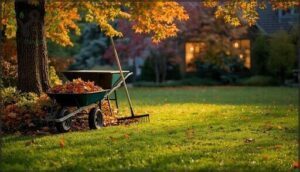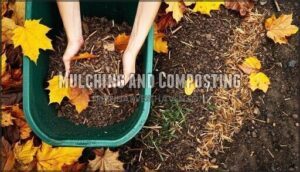This site is supported by our readers. We may earn a commission, at no cost to you, if you purchase through links.
 Fall’s shorter days signal your garden’s need for immediate action.
Fall’s shorter days signal your garden’s need for immediate action.
Start with essential fall garden maintenance tips: rake leaves and overseed bare lawn patches, then fertilize cool-season grasses before frost hits.
Clear perennial beds of debris while planting spring bulbs and applying protective mulch.
Clean out vegetable gardens, compost plant waste, and prepare soil for next season.
Water trees and shrubs deeply, then prune strategically to prevent winter damage.
Don’t forget tool maintenance—clean, sharpen, and store equipment properly.
These vital tasks create the foundation for spring’s success, but timing and technique make all the difference.
Table Of Contents
- Key Takeaways
- Preparing Lawns for Fall
- Caring for Perennial Gardens
- Refreshing Vegetable Gardens
- Maintaining Trees and Shrubs
- Organizing Tools and Preparing for Winter
- Frequently Asked Questions (FAQs)
- How do I prepare my garden for fall?
- What are some autumn garden tips?
- What to do in autumn to keep busy in the garden?
- What should be included in a fall landscaping checklist?
- How do you clean up a plant in the fall?
- How do you care for a fall cut flower garden?
- What are some fall gardening tips?
- What is fall garden prep?
- What should you do to prep your garden tools for winter?
- How do you care for your garden in the fall?
- Conclusion
Key Takeaways
- Prioritize lawn care early – You’ll need to rake leaves regularly, overseed bare patches, and fertilize cool-season grasses before the first frost hits for optimal spring growth.
- Clean and prep garden beds now – Remove all debris, dead plants, and weeds from vegetable and perennial gardens to prevent overwintering pests and diseases.
- Plant spring bulbs and mulch beds – You should plant tulips, daffodils, and crocuses while applying protective mulch around trees, shrubs, and perennials after the ground begins to freeze.
- Maintain tools and water deeply – Clean, sharpen, and store your garden equipment properly while giving trees and shrubs deep weekly watering until the ground freezes.
Preparing Lawns for Fall
Your lawn needs extra attention before winter arrives to guarantee healthy growth come spring.
Fall’s cooler temperatures and increased moisture create perfect conditions for strengthening grass roots and establishing new growth that’ll survive the cold months ahead, which is crucial for healthy growth.
Raking Leaves and Dethatching
Don’t let autumn’s carpet of leaves become your lawn’s worst enemy! When leaves accumulate thicker than half an inch, they block sunlight and trap moisture, creating perfect conditions for mold and turf diseases like snow mold.
Looking at this lawn care content, here’s an engaging blockquote that captures the same urgent, friendly tone:
Thick leaf layers spell trouble for your grass—act fast before mold moves in!
Effective leaf raking and thatch removal protect your grass from suffocation while promoting healthy spring growth.
Here’s your action plan:
- Rake regularly from late September through November, especially after peak leaf drop
- Use adjustable leaf rakes with ergonomic handles on dry days for maximum efficiency
- Apply power rakes or vertical mowers for thatch layers exceeding 0.5 inches thick
- Compost shredded leaves instead of bagging—they’ll decompose into nutrient-rich soil amendments
Lawn aeration works best alongside dethatching, allowing water and fertilizers to penetrate effectively.
This fall garden maintenance routine prevents spring disease outbreaks while giving your yard cleanup efforts lasting benefits. To achieve ideal results, choosing the right leaf raking tools for your specific lawn conditions is key.
Overseeding Bare Patches
Anyone can transform those stubborn bare spots into lush green patches with proper overseeding techniques. Fall’s cool temperatures and consistent moisture create perfect conditions for grass growth and lawn repair.
Seed selection matters—choose cool-season grasses that match your existing lawn for seamless integration.
| Bare Spot Size | Seed Amount | Watering Schedule |
|---|---|---|
| Small (1-2 sq ft) | 1-2 tablespoons | Light mist 2x daily |
| Medium (3-5 sq ft) | 1/4 cup | Water 15 mins daily |
| Large (6+ sq ft) | 1/2 cup+ | Deep water alternate days |
| Shaded areas | Shade-tolerant mix | Reduce frequency by half |
| High-traffic zones | Dense seeding rate | Monitor for compaction |
Essential soil prep involves loosening compacted earth with a rake before spreading seed evenly. This fall garden maintenance tip guarantees maximum overseeding success, giving you fewer weeds and healthier lawn care come spring.
Proper soil preparation methods are vital for a thriving lawn and garden ecosystem.
Continuing Lawn Watering
After overseeding, you’ll need to maintain proper lawn hydration throughout autumn. Cool-season grasses don’t stop growing when temperatures drop—their roots stay active until soil freezes, making consistent soil moisture critical for winter survival.
Irrigation systems should deliver deep, weekly watering when rainfall falls short. This autumn lawn care practice helps grass store nutrients for dormancy while supporting healthy root development.
Here’s your fall gardening tips for effective watering:
- Water deeply once weekly rather than frequent shallow sessions
- Monitor soil moisture levels 2-3 inches below surface
- Adjust irrigation systems based on rainfall patterns
- Continue until ground begins freezing
Smart water conservation during drought management guarantees your lawn emerges stronger next spring, making this winterizing step as important as fertilization.
Mowing and Weed Control
Don’t hang up your mower just yet! Keep mowing your grass at 2.5-3 inches until frost arrives – this height promotes stronger root systems that’ll weather winter better.
Sharp blades make clean cuts that prevent disease, so give yours a quick tune-up for ideal mower maintenance.
Fall temperatures create perfect conditions for weed control, so tackle those stubborn dandelions and crabgrass with herbicide applications while it’s still above 50°F.
Think of it as your lawn’s final health check before its winter nap. Don’t forget edge trimming around walkways for that polished look that’ll last through the dormant season.
Fertilizing Cool-Season Grasses
Cool-season grasses continue root development even as temperatures drop, making fall the prime window for fertilization.
Apply slow-release nitrogen fertilizer when temperatures reach 60-70°F, typically between early September and mid-October.
Use a crisscross pattern for even coverage—spread half in one direction, then perpendicular.
This nutrient-rich soil preparation strengthens winter hardiness and guarantees vibrant spring growth.
Caring for Perennial Gardens
Your perennial garden needs targeted fall care to survive winter’s harsh conditions and emerge stronger next spring.
This critical maintenance window sets the foundation for vibrant blooms and healthy plant growth throughout the coming growing season, which is essential for the garden’s overall health and healthy plant growth.
Removing Weeds and Debris
Now’s the perfect time to tackle weed control and debris removal in your perennial beds. Pull weeds completely, roots and all, to prevent spring regrowth—think of it as evicting unwanted tenants before they settle in for winter.
Clear fallen leaves and plant debris that harbor pests and diseases, giving your perennials breathing room.
Garden cleanup tasks include:
- Remove all weeds, including root systems
- Clear fallen leaves from plant crowns
- Dispose of diseased or pest-damaged material
- Rake up accumulated organic debris
- Sanitize pruning tools between plants.
This yard sanitizing routine prevents overwintering problems and sets the stage for healthy spring growth.
Planting Spring-Blooming Bulbs
With weeds cleared, now’s the time to plant spring-blooming bulbs for spectacular garden color. Bulb selection starts with choosing tulips, daffodils, and crocuses suited to your sunlight conditions.
Soil preparation involves loosening earth to 12 inches deep with compost added.
| Bulb Type | Spring Reward |
|---|---|
| Tulips | Bold, vibrant cups |
| Daffodils | Cheerful golden faces |
| Crocuses | Delicate purple gems |
Planting depth follows the "three times rule"—plant bulbs at 2-3 times their height. Bloom timing depends on variety selection and garden design placement.
Apply mulch after ground freezes for winter protection, ensuring your fall garden maintenance tips pay off with stunning spring displays.
Deadheading Perennials
After planting bulbs, you’ll want to tackle deadheading perennials before winter arrives. This flower care practice removes spent blooms, redirecting energy toward root development rather than seed production. Your gardening tools make quick work of this plant health maintenance.
Here’s why deadheading transforms your perennial care routine:
- Prevents energy waste – redirects nutrients to strengthen roots
- Reduces disease risk – eliminates decaying material harboring pathogens
- Maintains garden aesthetics – keeps beds looking tidy through fall
- Encourages late blooms – some varieties rebloom with proper blossom management
For fall gardening tips, leave select seedheads like coneflowers for wildlife while removing others completely. Understanding spring perennials gardening is vital for a successful shift into the next growing season.
Pruning and Dividing Perennials
After deadheading, proper pruning techniques and division methods become essential for perennial care.
Fall’s cooler temperatures create ideal conditions for plant renewal and enhanced root growth. Sharp, clean tools prevent disease transmission during division.
| Perennial Type | Best Division Timing |
|---|---|
| Spring bloomers | Early fall (September) |
| Summer bloomers | Late fall (October) |
| Ornamental grasses | Before new growth |
| Hostas | After foliage yellows |
| Daylilies | 4-6 weeks before frost |
Cut overcrowded plants back to 6 inches, then carefully separate root clumps using garden forks. Each division needs healthy roots and growing points. Replant immediately at original depth, water thoroughly, and expect stronger blooms next season from these fall gardening tips.
Mulching and Composting
With fall garden maintenance underway, mulching and composting become your secret weapons for winter protection.
Apply 4-5 inches of organic mulch after ground freezes to insulate soil and suppress weeds.
Build your compost pile with these decomposition-friendly ingredients:
- Shredded leaves (decompose faster than whole leaves)
- Vegetable garden waste and plant debris
- Fresh grass clippings from final mows
- Coffee grounds for nitrogen enrichment
- Fruit peels and kitchen scraps
Different mulch types like bark chips, straw, or composted leaves provide soil enrichment while protecting perennials through harsh winter months.
Refreshing Vegetable Gardens
Your vegetable garden deserves one final round of attention before winter settles in.
These essential fall tasks will set the stage for a more productive and healthier growing season next year.
Cleaning Out Beds and Removing Debris
Clear your vegetable beds now to break pest cycles and prevent disease carryover.
Start by removing all spent plants, fallen fruits, and weeds that harbor pathogens through winter. This garden cleanup dramatically improves soil health and garden aesthetics while supporting effective pest control.
| Remove | Why |
|---|---|
| Dead plants & debris | Preventing overwintering pests and diseases |
| Fallen fruits | Disease reduction and pathogen elimination |
| Weeds and roots | Interrupts pest life cycles |
Don’t forget leaf removal from beds—soggy leaves create perfect breeding grounds for fungal problems.
After cleaning, apply a thin mulch layer to protect soil structure. This fall garden maintenance step sets you up for a healthier growing season ahead.
Composting Garden Waste
After cleaning out spent plants and debris, your garden waste becomes valuable compost materials for soil enrichment.
Create nutrient-rich organic matter by layering green materials (nitrogen-rich kitchen scraps, fresh plant debris) with brown materials (carbon-rich dried leaves, paper). This garden recycling approach supports waste reduction while building healthy compost piles.
Effective compost management involves using proper compost bins to maintain aeration and temperature.
Here’s your composting game plan:
- Layer properly: Alternate green and brown materials in 3:1 carbon-to-nitrogen ratios
- Maintain moisture: Keep your compost pile as damp as a wrung-out sponge
- Turn regularly: Aerate weekly to speed decomposition and prevent odors
- Size matters: Chop materials into smaller pieces for faster leaf mold creation
This organic matter will transform your soil structure next spring.
Sowing Cover Crops
Your garden’s empty beds present perfect opportunities for soil erosion prevention through strategic cover crop planting.
These green manure crops protect and enrich soil during winter months while supporting crop rotation principles.
Winter legumes like crimson clover excel at soil replenishment through nitrogen fixation.
Consider these proven options:
- Winter rye – Superior erosion control and soil health enhancement
- Crimson clover – Fixes nitrogen while preventing nutrient-rich soil depletion
- Daikon radish – Breaks compacted layers with deep taproots
- Austrian winter peas – Provides up to 150 pounds nitrogen per acre
Plant 4-6 weeks before first frost for ideal establishment.
This winterization strategy transforms bare ground into productive composting systems that’ll reward you with healthier soil come spring.
Harvesting Remaining Crops
Time to secure your fall harvest before winter’s first frost steals your garden yield! Gather tomatoes, peppers, and beans while they’re still viable.
Proper crop storage guarantees your winter produce stays fresh longer. Save seeds from your best performers for next season’s crop rotation strategy.
| Crop Type | Storage Method |
|---|---|
| Green tomatoes | Wrap in newspaper, ripen indoors |
| Root vegetables | Store in cool, dark basement |
| Beans/peas | Dry thoroughly, freeze or can |
| Herbs | Hang bundles to air-dry |
This autumn garden care protects months of hard work from going to waste.
Preparing Soil for Next Season
With your harvest complete, fall garden maintenance shifts to soil preparation for next season’s success.
Think of your soil as a savings account – the more you invest now, the richer your spring yields will be.
Start your soil preparation with these three key steps:
- Soil Testing – Check pH levels and nutrient content to guide your amendments
- Compost Addition – Apply 2-3 inches of organic matter for soil enrichment and structure
- Mulch Application – Layer protective covering to prevent erosion and retain moisture
This foundation sets the stage for vibrant spring growth through proper composting and pH balancing techniques.
Maintaining Trees and Shrubs
Your trees and shrubs need strategic fall attention to survive winter’s harsh conditions and thrive come spring.
This critical maintenance window gives you the perfect opportunity to establish strong root systems, protect vulnerable bark, and set up your woody plants for robust growth next year.
Planting New Trees and Shrubs
While summer fades into autumn, fall presents your garden’s golden opportunity for tree selection and shrub care.
This season’s cooler temperatures and increased rainfall create ideal conditions for root establishment before winter’s dormancy period. Choose bareroot or container specimens from nurseries, focusing on soil preparation by digging holes twice as wide as root balls.
Position plants at their original nursery depth—never deeper—and backfill with native soil. Planting now gives your shrubs and trees months to develop strong root systems.
Complete your fall yard work with thorough watering after transplanting, and consider trunk protection for younger specimens. This garden maintenance timing guarantees robust spring growth.
Proper fruit tree care techniques, such as those involving disease resistance methods, can greatly impact the health and productivity of your trees.
Watering and Mulching
After planting new trees and shrubs, water them deeply once weekly until ground freezes.
Apply 2-3 inches of mulch around the base, keeping it away from trunks for proper soil insulation and moisture retention.
Here are five effective mulch types for winter insulation:
- Shredded bark – Provides excellent root protection and slowly decomposes
- Wood chips – Offers superior water conservation and long-lasting coverage
- Compost – Enriches soil while maintaining soil moisture levels
- Pine needles – Creates natural acidity for acid-loving plants
- Straw – Lightweight option that’s easy to apply and remove
This mulching strategy protects your investment through winter’s harsh conditions.
Pruning and Guarding Trunks
After watering, you’ll want to focus on tree pruning and trunk protection while trees enter dormancy.
Wait until leaves drop—this signals dormancy and reduces pruning stress. Remove dead, diseased, or damaged branches with clean cuts at the branch collar.
Trunk wrapping protects young bark from winter guarding threats like sun scald and deer damage. Use trunk guards or burlap around vulnerable trees.
This plant protection prevents costly damage that’s much harder to fix than prevent. Smart tree trimming now sets your landscape up for healthy spring growth.
Fertilizing Trees and Shrubs
After protecting tree trunks from winter damage, your woody plants need proper nutrition to survive harsh conditions ahead. Fall garden maintenance tips include strategic fertilizing during September through October when soil temperatures remain above 40°F.
Apply tree fertilizer with balanced N-P-K ratios like 10-10-10 within the drip line for ideal nutrient balance. Soil testing reveals specific deficiencies, allowing targeted shrub care approaches.
Slow-release granular fertilizers work best for winter feeding, providing sustained nutrition without promoting frost-prone growth. Skip newly planted specimens—they’re still establishing roots.
Focus garden fertilization efforts on established trees showing pale leaves or sluggish growth. Tree and shrub care through proper timing maximizes nutrient absorption before dormancy begins.
Protecting From Pests and Diseases
Before tackling fall’s final stretch, inspect your trees and shrubs for lurking pest control issues and disease prevention needs.
Remove infected leaves and debris to break disease control cycles. Apply dormant oil sprays for garden pests while protecting beneficial insects. Install trunk guards against rodents and check for garden diseases regularly.
- Fungal treatments work best when applied before dormancy begins
- Insect barriers like burlap wraps prevent egg-laying in bark crevices
- Weed management around tree bases eliminates pest hiding spots
- Copper-based fungicides target common fall diseases like fire blight
- Regular monitoring catches problems before they become expensive headaches
Organizing Tools and Preparing for Winter
As winter approaches, proper tool maintenance and garden preparation become essential for protecting your investment and ensuring smooth spring startup.
You’ll want to clean, sharpen, and store your equipment while also winterizing irrigation systems and securing garden structures to prevent costly damage from freezing temperatures and harsh weather conditions, which is crucial for protecting your investment.
Cleaning and Sharpening Tools
Clean garden tools transform winter prep from chore to craft. Start with soapy water to remove soil and debris, then disinfect with a bleach solution to prevent disease spread between plants.
Sharp blades on pruners, loppers, and shovels make spring work effortless. Regular use of a tool sharpener device can substantially improve tool performance.
| Task | Benefit |
|---|---|
| Blade Sharpening | Cleaner cuts, healthier plants |
| Oil Treatment | Prevents rust, extends tool life |
| Handle Conditioning | Stops cracking, improves grip |
Apply vegetable oil to wooden handles and coat metal parts for rust prevention during storage.
Storing and Preparing Equipment
Your garden tools’ winter retreat requires strategic planning to guarantee they emerge ready for spring action.
Proper tool storage protects your investment and prevents costly replacements.
Store your garden equipment systematically:
- Organize your shed space – Hang tools on pegboards or wall hooks to prevent moisture damage and rust formation
- Drain all fuel systems – Remove gasoline from mowers, tillers, and other power equipment, adding fuel stabilizer if storing with gas
- Apply protective coatings – Wipe metal surfaces with light machine oil to create a barrier against winter corrosion
This equipment cleaning and gear maintenance routine transforms your shed organization into a well-oiled machine for next season’s gardening adventures.
Winterizing Irrigation Systems
When winter temperatures drop below 40°F, winterizing irrigation systems becomes critical for frost protection. Start by shutting off your main water supply and draining systems using manual drain valves or professional sprinkler blowout methods.
Protect exposed winter valves and pipes with quality pipe insulation. Don’t forget backflow prevention and outdoor water faucet protection during sprinkler shutdown!
Protecting Garden Structures
Beyond irrigation, your garden structures need protection from winter’s harsh reality.
Reinforce trellises and stakes, checking for loose connections that’ll snap under snow loads. Garden Fence repairs prevent small issues from becoming major headaches—tighten boards and replace damaged sections now.
Shed Maintenance includes sealing cracks and organizing tools inside.
Clean greenhouse vents and check heating systems for proper winterizing.
Don’t forget Gate Repair—a functioning entrance keeps your garden accessible all season long.
Reviewing Spring Maintenance Tasks
Now’s the perfect time to plan your spring preparation while this year’s gardening lessons are fresh in your memory.
Creating a thorough spring task review sets you up for success when warmer weather returns.
Here’s your garden planning checklist:
- Document this year’s soil testing results and amendment needs
- Schedule tool maintenance and equipment replacement priorities
- Plan your garden budgeting for seeds, plants, and supplies
- Outline yard cleanup priorities based on current observations
- Create monthly seasonal plant care timelines for efficient workflow
Understanding winter garden preparation is vital for a healthy garden.
Smart garden maintenance tips start with winter reflection.
Frequently Asked Questions (FAQs)
How do I prepare my garden for fall?
Start by cleaning up debris and dead plant material to prevent overwintering pests and diseases. Add compost, plant cover crops, and mulch around trees and shrubs for winter protection.
What are some autumn garden tips?
You’ll want to rake leaves, plant spring bulbs, prune dormant perennials, and mulch beds. Don’t forget to aerate compacted soil and divide overcrowded plants.
What to do in autumn to keep busy in the garden?
You’ll want to clean up garden beds by removing dead plants and weeds.
Then plant spring bulbs and cool-season crops.
Don’t forget to mulch perennials and prepare soil with compost for next year’s growing season.
What should be included in a fall landscaping checklist?
Don’t think fall landscaping is overwhelming—breaking it down into manageable categories makes it simple.
You’ll need to: seed lawns, plant bulbs, prune perennials, clear debris, mulch beds, and prepare soil for spring success.
How do you clean up a plant in the fall?
Cut back spent perennials to one-inch stems after they turn brown, removing dead blooms and diseased foliage. Clear debris to prevent pest overwintering while marking plant locations.
How do you care for a fall cut flower garden?
Fall cut flower gardens reach peak productivity when daisy-type flowers produce 40% more blooms with proper deadheading.
You’ll want to deadhead spent blooms regularly, water deeply twice weekly, and apply balanced fertilizer monthly to extend flowering through frost.
What are some fall gardening tips?
Rake fallen leaves to prevent lawn damage.
Plant spring bulbs like tulips and daffodils, clean vegetable beds of debris.
Add compost to enrich soil, and mulch around trees and shrubs for winter protection.
What is fall garden prep?
Preparing your garden for winter involves strategic cleanup, soil improvement, and plant protection. You’ll remove debris, add compost, plant cover crops, mulch beds, and protect vulnerable plants from frost damage.
What should you do to prep your garden tools for winter?
Clean and oil metal tools, sharpen blades, remove rust with steel wool, and store in a dry location.
Drain fuel from power equipment, replace spark plugs, and apply protective coatings to prevent winter corrosion damage.
How do you care for your garden in the fall?
Your garden thrives with strategic fall care: rake leaves, overseed bare spots, plant spring bulbs, clean beds, add compost, water deeply, and mulch after freezing.
Conclusion
Properly executing these fall garden maintenance tips will absolutely transform your landscape’s winter survival and spring emergence.
You’ve invested time in raking, overseeding, mulching, and pruning—tasks that create resilient growing conditions.
Your trees and shrubs now have deep root hydration, while clean tools await spring’s arrival.
These seasonal preparations guarantee vigorous growth when temperatures warm, making your garden’s dormant period a foundation for next year’s success.
- https://www.johnson.k-state.edu/programs/lawn-garden/agent-articles-fact-sheets-and-more/agent-articles/soil/fall-garden-soil-preparation.html
- https://www.reddit.com/r/selfreliance/comments/uqddxt/guide_grow_your_best_fall_garden_vegetables_what/
- https://extension.wvu.edu/lawn-gardening-pests/gardening/garden-management/controlling-garden-pests
- https://www.almanac.com/fall-vegetable-garden-cleanup-11-things-do-now
- https://scapeworx.com/7-benefits-of-fall-perennial-pruning/















